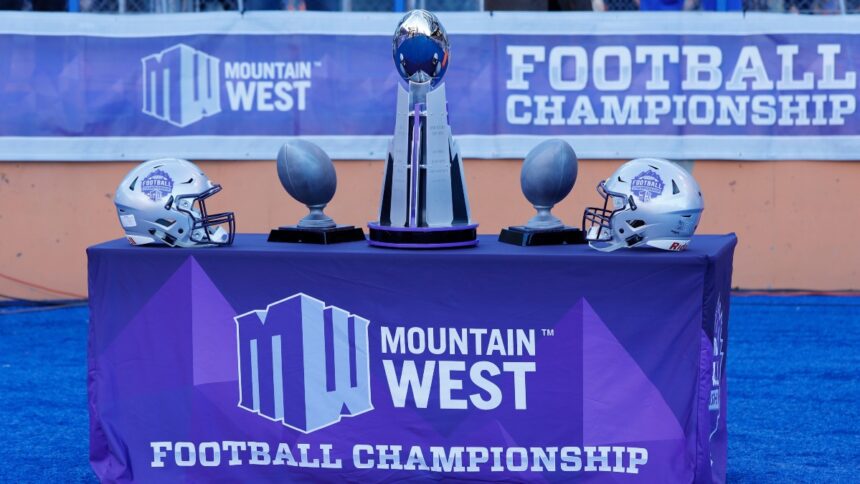The college sports world has been scrambling over the past year as most of the Pac-12 teams have decided to leave the conference. While several factors are at play, money and media deals have been key among them.
And now, after those programs have decided to move on, the Group of Five leagues have begun to be affected. The teams left in the Pac-12 have limited options ahead of them.
Here’s a look at what has happened and how it has impacted the G5.
Explore New Customer Offers at BetMGM
Bonus Bets Expire in 7 Days. One New Customer Offer Only. Add’l Terms
Which Teams Are Leaving The Pac-12?
USC, UCLA, Oregon, and Washington have decided to go to the Big Ten, and Colorado, Arizona, Arizona State, and Utah have chosen to head to the Big 12.
Then news broke that Cal and Stanford would be going to the ACC in 2024. That leaves just two teams left in the Pac-12.
Who Is In The Pac-2?
Washington State and Oregon State are the only programs remaining in the Pac-12. Some began calling them the Pac-2.
When Cal, Stanford, WSU, and OSU were the only teams left in the Pac-12, people referred to them as the Pac-4. However, Stanford and Cal are now going to the ACC.
With OSU and WSU facing an unclear future, both teams saw some success this past year and were both ranked in the AP Top 25 at one point.
SMU, Stanford, And Cal Head To ACC
SMU, Stanford, and Cal will be members of the ACC beginning in 2024.
However, all three schools reportedly won’t receive full ACC revenue shares for nine years.
SMU has been a member of the AAC since 2013 but has been regarded as another team which might move on to the Power Five. SMU announced it raised $100 million in just seven days to help support its transition to its new league.
Clemson & FSU’s ACC Lawsuits
After the Pac-12 imploded, some have begun to wonder if the same would happen to the ACC.
Clemson and Florida State have both sued the ACC in recent months over matters related to the league’s grant of rights.
Florida State has reportedly expressed frustration with the ACC’s media deal for months, saying FSU isn’t making enough to keep up with SEC and Big Ten programs also seeking to win national championships.
For example, the nine FBS leagues recently signed off on a six-year College Football Playoff arrangement through 2031 that would give the Big Ten and SEC nearly twice as much money as the ACC and Big 12.
Florida State has argued the ACC has mismanaged its TV agreement with ESPN, The Athletic reported. FSU is also seeking for a court in Florida to rule whether the ACC’s grant of rights is legitimate.
Clemson is questioning the legitimacy of the ACC’s grant of rights when it comes to a school leaving the conference.
Sports media experts have argued Clemson and Florida State’s cases against the ACC aren’t very strong, which could prevent the conference from dissolving anytime soon. However, that doesn’t mean it isn’t impossible.
Those schools could come up with the financial means to separate from the ACC, or perhaps all parties involved come to an amicable solution which means those two programs can seek a new conference.
But if that did happen, the ACC would be losing arguably its two most valuable members when it comes to college football. And like what happened with the Pac-12, some big-name schools leaving could lead to several others wanting out as well.
A judge reportedly decided this week to grant a temporary restraining order against North Carolina’s board of trustees. That means the board can’t go over things like finances or conference realignment in a closed session.
For the sake of the Group of Five, if the ACC were to completely dissolve, it’s not impossible some programs are left behind by the power leagues. Perhaps the AAC or the Sun Belt figure out an arrangement with leftover ACC teams.
AAC/Pac-12 Potential Moves
The American Athletic Conference was reportedly interested in adding the remaining Pac-12 schools, but then the AAC stopped considering those moves.
This is where it gets interesting for Group of Five fans. The AAC has expressed disapproval of the G5 label, and additions like that would certainly help the conference position itself as the next-highest league in many aspects after the Big Ten, SEC, Big 12, and ACC.
While the American recently lost UCF, Cincinnati, and Houston to the Big 12, the teams that joined the AAC last year were UTSA, FAU, North Texas, Rice, UAB, and Charlotte. The AAC presidents also recently voted to add Army as a football-only member beginning next season.
OSU, WSU To The Mountain West?
Oregon State and Washington State have officially made a scheduling deal with the Mountain West for at least next season. There’s still the possibility of there being a Mountain West/Pac-2 merger or those two schools joining the Mountain West eventually.
The Mountain West announced MW teams will schedule seven games against league opponents with another being against either WSU or OSU in 2024. Those two programs wouldn’t be eligible for the Mountain West Championship.
For one year of this arrangement, the two schools would pay the Mountain West $14 million, according to Yahoo Sports. This partnership could also last until the 2025 season as well and, for now, only applies to football. Other WSU and OSU athletic teams will be affiliate members of the West Coast Conference in 2024-25 and 2025-26.
Of any conference that seems like the future home for Oregon State and Washington State football teams, the Mountain West makes the most sense. Mountain West commissioner Gloria Nevarez has proposed to OSU and WSU reasons why they should join the league, per CBS.
Pac-12 News And Rumors
A promotion/relegation model similar to that of European soccer could also be possible for the Pac-12 and Mountain West, Ross Dellenger of Yahoo Sports reported.
With this idea, every one or two years, two teams would move up to the Pac-12 and another two would move down to the Mountain West based on success. This operation could also expand by adding FCS teams like North Dakota State and South Dakota State.
Some Mountain West decision-makers are reportedly open to unique ideas like this, but not everyone might be in favor of this model and plenty more would have to be solidified. Washington State and Oregon State still have matters to sort out with the remaining Pac-12 assets, so a decision regarding this matter might not be made in the immediate future.
Pac-12/Sun Belt Scheduling Alliance?
The presidents of Sun Belt Conference schools met during this past season to go over potential plans by Oregon State and Washington State that would include a scheduling alliance between the Sun Belt and those two schools, according to Yahoo Sports.
However, those discussions were reportedly short. The Sun Belt’s leaders believed there was too much travel and not enough financial gain possible with an arrangement like that.
CFP’s Move To 5+7 Format Impacting G5 Teams
The College Football Playoff is changing its format in 2024, and this directly affects the Group of Five.
The CFP Board of Managers unanimously decided on Tuesday to alter the setup for the playoff. Now, the five highest-ranked conference title winners will automatically qualify, and the next seven highest-ranked teams will make up the rest of the field.
Previously, the six highest-ranked conference champions would make it. Then the next-highest ranked six teams would consist of the rest of the field.
This means at least one Group of Five team will make the CFP. The previous rules would’ve guaranteed spots for at least two G5 programs, but it was unlikely that those rules were going to stand after most of the Pac-12’s members departed for other leagues.
G5 representatives on the CFP Board of Managers includes Western Kentucky President Tim Caboni (Conference USA), Tulane President Michael Fitts (AAC), Troy President Jack Hawkins (Sun Belt), Buffalo President Satish Tripathi (MAC), and UNLV President Keith Whitfield (Mountain West).
“This is a very logical adjustment for the College Football Playoff based on the evolution of our conference structures since the board first adopted this new format in September 2022,” Mark Keenum, Mississippi State President and Chair of the CFP Board of Managers, said in a press release. “I know this change will also be well received by student-athletes, coaches and fans. We all will be pleased to see this new format come to life on the field this postseason.”
College Football Playoff Rules
This year is the CFP’s first season of 12 teams making the playoffs.
Despite the 5+7 change, no conference – including the Power Five – will have an automatic qualifier, and there will be no maximum for a number of teams from any one conference.
With this new format, the four highest-ranked conference title winners will receive a bye during the first round. The next eight teams will be seeded Nos. 5-12, and the higher-seeded programs will host.
Then the quarterfinals and semifinals will be made up of the New Year’s Six bowls, and the national championship will keep being played at a neutral site.
Can A Pac-12 Team Make The College Football Playoff?
Washington State and Oregon State, the two remaining Pac-12 teams in 2024, still can earn a spot in the CFP. However, that path will be difficult without a chance to automatically qualify with a conference championship.
This change is happening in the wake of massive FBS conference realignment. Most of the Pac-12’s members will be playing in other Power Five conferences next season. OSU and WSU agreed to a scheduling alliance with the Mountain West for 2024.
With the Pac-12 being down to two members, it appears unlikely the conference’s No. 1 team would automatically make the playoff as things stand right now. Oregon State and Washington State also won’t be eligible for the Mountain West’s conference title.
Pac-12 Lawsuit And Hearing
Washington State and Oregon State leaders appeared at a hearing last year in Whitman County Superior Court in Washington. A judge ruled in favor of OSU and WSU, meaning they were going to be the Pac-12 board’s only two voting members.
Earlier this year, the Washington Supreme Court ruled in favor of OSU and WSU by not reviewing an appeal of the lower court’s decision, which was made by the departing members of the league. That means OSU and WSU remain in control of the board.
The current Pac-12 members did come to an arrangement that puts an end to those legal issues for now, though. The member programs which are leaving are giving up some but not all of the funds from this school year. With OSU and WSU in control of the Pac-12 board, the league will keep its future money and resources after this academic year.
Hundreds of millions of dollars from television deals and other sources of income have been at stake in this dispute.
The Mountain West agreed to a $270 million media rights deal in 2020 with CBS and FOX, according to The Athletic. It would end after the 2025-26 season. Teams are scheduled to be paid $4 million per year.
The AAC and ESPN agreed to a 12-year contract worth about $1 billion, via USA Today. The deal began in 2019. It was to pay each program just under $7 million per year when it was made.











